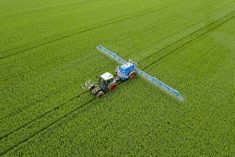Air can dry grain, or it can make it wetter.
That’s because grain automatically reaches equilibrium with the ambient relative humidity as it is drawn into the bin via fans.
Theoretically, this fact could be used to boost profits by adding tonnage via moisture content until the grain reaches the optimum nine to 10 per cent moisture content, participants heard at a recent Manitoba Canola Growers Association workshop.
But just like sticking a garden hose in the auger to wet down grain going into the bin, the ethics of such a practice are questionable, said Joy Agnew, a researcher at the Prairie Agricultural Machinery Institute (PAMI), who gave a presentation on optimizing canola storage.
Read Also

CUSMA access key among other trade noise: Seeds Canada panel
Seeds Canada conference panelists say Canada needs to stay focused and wait as U.S. trade and tariff chaos develops, and a Canada-U.S.-Mexico Agreement review looms
“There is potential to rewet grain. The idea is to result in an even moisture content at the end, but the added benefit is that you’re adding revenue,” said Agnew, in response to a question forwarded over the Internet.
“I’ve heard the garden hose thing is illegal, but it’s really the same thing. You’re adding nature’s moisture to it.”
Costly exercise
Overdrying grain, on the other hand, can be a costly exercise.
Consider a 2,000-bushel bin filled with slightly tough canola fresh off the field and a case where the farmer switches on the fans to dry it down for a few days and only switches them off when he discovers moisture is down to eight per cent. If 10 per cent moisture is allowable, the farmer has now lost just over a tonne of marketable weight by overdrying the grain, as well as the electricity cost.
“If canola is selling for $557 per tonne, this represents just over $600 in lost revenue. That’s just from a single 2,000-bushel bin, which is actually pretty small,” said Agnew.
Last year, when canola came off the field at a moisture level so low that it was virtually unmeasurable, possibly three per cent, one farmer that she knows tried running his fans only at night when relative humidity was higher for a week, then mixing the crop with other canola.
The result was an increase in moisture content to around seven per cent. The value gained was considerable, she added.
For example, rewetting canola from six per cent moisture to seven per cent adds more than $900 to its selling value per 1,000 bushels. Bumping that same amount up to 10 per cent would result in a gain of more than $1,400.
How feasible is a grain moisture control system?
Control
PAMI’s experimental system used four temperature and relative humidity sensors at $50 each, three in the grain and one at the fan inlet per bin, plus relays to switch the fans on and off. A computerized controller with a user interface could be used to operate up to 10 bins.
Commercially available units such as those offered by Calgary-based OPI-Integris are designed for large bins only, or around 100,000 bushels.
Agnew also compared the advantages of natural air-drying systems versus those using supplementary heat.
Natural air drying (NAD) systems are cheaper both in terms of equipment as well as in energy savings, and result in better-quality grain. NAD systems are also better for storing seed canola, because the high heat and high airflow rates in heated systems can reduce germination. However, this method is not recommended when the ambient air temperature is lower that 10 C, because cooler air has less drying capacity.
In general, bin size determines fan horsepower requirements, she added.
Guidelines say that for a 2,000-bushel bin, the fan needs three hp. That rises to five hp for 3,500 bushels, and seven to 10 hp for 5,000-bushel bins. But grain bin diameter also affects drying speed, because airflow depends more on depth than volume.
More horsepower
Tall, narrow-diameter bins need more horsepower to achieve optimum static pressure.
If grain is augered into bins leaving a cone-shaped pile on top, drying time with NAD systems can be increased by up to 50 per cent. For larger-diameter bins, a grain-spreading device should be used to flatten out the peak and prevent pocket-forming accumulations of fine particles.
Agnew said that PAMI research shows that there is no danger of extrusion, whether for high oil varieties or regular, for bin depths of up to 100 feet.
Storing canola requires special care, she added, because the grain continues to respire for up to six weeks after harvest. Even though grain may be taken off perfectly dry, it can still heat up in the bin because it creates its own “biological heat.”


















